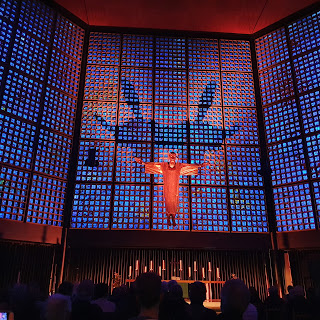 |
| Silent Green, Berlin |
By Paul Acquaro
Thursday night at Boulez Hall
minute bike ride, show our proof of vaccination, scan the tickets, peel off our
wet rain clothing, and find our seats. We were a bit frazzled by the time we
located our places in the upper balcony of the lush ovular hall. Through a light
clatter from the drums, a rustle of musical scores, and a few dolphin calls
emanating from the bass, we began to settle in. Then, the first notes from Swedish
pianist Bobo Stenson flowed from his keyboard and our nerves were quickly
subdued.The first night of the Jazzfest Berlin was off to a start.
The main part of the festival was at the Silent Green culture center about 8
kilometers from the classical music hall that this concert was taking place in.
The festival, which has been shifting and growing, extending and morphing over
the past several years, was back in person (an online), after being forced to be
entirely online last year, and spread out even further than before. The
constraints of the pandemic last year fostered a connection with Roulette in New York City, where a live stream connected the cities. This year, the idea
grew with live streams from concerts in South Africa (curated by Jess White
in Johannesburg), and multimedia contributions from Brazil (Juliano Gentile and
Manoela Wright for São Paulo) and Egypt (Maurice Louca in Cairo). In Berlin,
aside from the Silent Green, and tonight, Boulez Hall, the festival also would
be featuring the famous Kaiser Wilhelm Memorial Church in Charlottenburg, the nerve
center of former West Berlin. More about these locations later, now back to
Stenson’s trio.
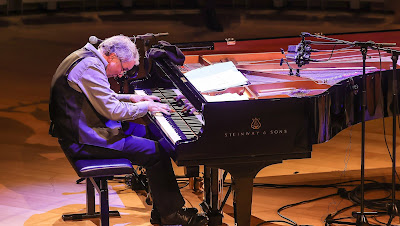 |
Bobo Stenson. (c) Roland Owsnitzki / Berliner Festspiele |
The music was ebullient, but at the same time, reserved. This seems
to be the pianists trademark. Effortlessly, his melodies intertwined with Anders
Jormin’s bass bowing, and the bright – and sometimes humorous – responses from
Jon Fält’s percussive accompaniment. The trio, aside from some selected
favorites, was presenting a set of new music that will be recorded for an
upcoming ECM release next year. From gentle, slightly dissonant intros to
pulsating, vibrant crescendos, the trio’s work was refined and radiant.
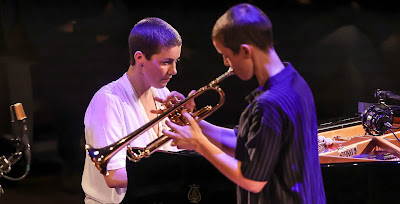 |
| Kaja Draksler and Susanna Santos Silva. Photo by Roland Owsnitzki / Berliner Festspiele |
The duo of trumpeter Susanna Santos Silva and pianist Kaja Draksler
followed. The two have been performing together for a decent portion of their
lives and alhough from opposite ends of Europe, they share an obvious musical
affinity. At the Boulez Hall Steinway grand piano, Draksler began with a series
tightly coupled, short phrases, while Silva seemed to emit what I can best
identify as microtones. Both seemed equally as apart in their playing as
connected on the outer edges, which was quite a contrast to the previous set.
As their interplay continued, the duo engaged in ever more complex parallel
play, hitting dissonant intervals and unexpected harmonies. The pathos grew as
Silva’s long legato tones changed to explosive bursts, and Draksler’s began
traveling energetically up and down the keyboard. The improvisation turned
inward towards its end, for example, plucked notes from inside and outside the
prepared piano and the ‘pop’ of the mouthpiece extruded from the trumpet made up
an extensive passage.
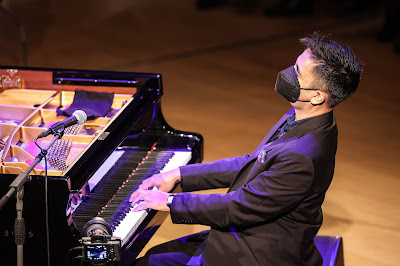 |
| Vijay Iyer. (c) Roland Owsnitzki / Berliner Festspiele |
The final set was from pianist Vijay
Iyer’s trio that recently released Uneasy – namely the pianist with drummer
Tyshawn Sorey and bassist Linda May Han Oh. It also happened to be the first date of
their European Tour and Iyer’s excitement was palpable. “The pandemic,” he said,
“has given us chance to realize what’s important and playing for all of you is
it.” Setting an example, he continued “we may play masked, but our hearts are
open.”
US, but it’s not geographically limited) over recent years, but in concert,
the energy that the trio generated on the tunes was staggering. Iyer’s playing was lyrical and rollicking, Oh’s bass playing was
kinetic and as much a part of the melody as the support, and Sorey’s work was
that of the conductor of this mini-orchestra. Songs like ‘Combat Breathing’
and the war horse ‘Night and Day’ are powerful on the recording, and live,
nearly combusting. Any wisp of musical exhaustion after the first two hour of
music was whisked away immediately by the gale winds from the trio.It was still raining when the concert ended, but it hardly
mattered, we were gliding through the night.
Saturday night at Silent Green.
As noted, the festival is expansive. Covering multiple nights
and multiple venues, it’s hard to take it all in, and, to be honest, it can be
bit of a sensory overload. I was still holding onto bits of Thursday’s show
when I arrived at the entrance to the former
crematorium turned cultural space in the Wedding district on Saturday. The 19th century buildings are
stately, the grounds surrounded by the period architecture that makes up the most stately parts of Berlin, and deep
underground, in the ‘Betonhalle’, the performance space is a high-tech set up. Large video displays
on each of the walls live-casted concerts and video installations, all showing
different angles. (During one set I was wondering why someone seemed to
starting directly and unflinchingly at me, until I realized he was
concentrating on the screen to my left, while I was intent on the one to the
front).
The opening show was a live-cast from Johannesburg.
Bassist and composer Shane Cooper and the Dinaledi Chamber Ensemble performed
a suite of new music. The music was pleasant as it explored and layered
folk-like melodies with light electronics and poly-rhythmic ideas.
 |
| Nate Wooley’s Columbia Icefield. (c) Cristina Marx/Photomusix |
drums opened the next set from trumpeter Nate Wooley and his Columbia Icefield
project. The mournful, charged, amplified breath blew a cold breeze across the
stage. It was musical dawn, and guitarist Ava Mendoza provided the first rays
of light breaking through the tonal darkness. Deep, thick
droning tones hovered in the background, emanating from Susan Alcorn’s pedal
steel guitar. As the music awoke, the textures came into sharp relief:
Wooley changing from a metallic rush of sound to a mournful melody, drummer
Ryan Sawyer adding additional texture, and Mendoza delivering aggressive
arpeggios and discordant tones.
where the Columbia River’s waters collide with the tumultuous Pacific ocean.
The tentatively titled tunes certainly projected this atmosphere. From the icy winds to the soaring grandeur. Plus, the ghosts
of western music are strongly bound with Alcorn’s instrument. While
her playing far transcends ‘country’, she brings something intangibly
‘western’ to the setting. The music is impressionistic and often slow moving,
but also at times explosive, it works its way between memory and feeling, and
leaves a long lingering impressions.My goal was to trace the physical breadth of the concert as much as possible with the time I had (I covered about 1/3 of the concerts, and 3/4 of the locations), so I left the
Betonhalle for the Kuppelhalle, after catching the first twenty minutes of the
riveting drummer/vocalist Maria Portugal’s set of explosive free-jazz and
Brazilian flavored music. At the Kuppelhalle, the smaller, cathedral-like
former mourning hall, Turkish vocalist Cansu Tanrıkulu performed with a trio
plus one. The trio, saxophonist Tobias Delius, bassist Greg Cohen, and the
plus one, guitarist Marc Ribot. How could I not be there? I would have surely
died from FOMO had I not been.
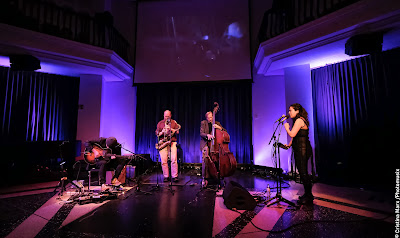 |
| Cansu Tanrıkulu Trio +1 (c) Cristina Marx/Photomusix |
Beneath projected video art featuring images of the vocalist,
emergency blankets, and CRT monitors, the trio + 1 wasted no time getting
started. Tanrıkulu’s otherworldly vocals sailed effortlessly through the
octaves and around Delius’ powerful lines. Throughout, Cohen was aflutter and
at first, Ribot – was he even plugged in? – scratched at his strings, but then
over Cohen’s unwavering rhythm, the guitarist starting building up a jazz
inflected solo that went from an acoustic whisper to splitting its pants. The
music, a freely improvised cocreation of the moment, was impulse and reaction.
It breathed naturally, unforced, and as precise as it was unexpected.
 |
| Ahmed (c) Cristina Marx/Photomusix |
Ahmed, an ensemble, named after oudist and bassist Ahmed Abdul-Malik,
comprised of British pianist Pat Thomas, French drummer Antonin Gerbal,
Berlin-based Swedish bassist Joel Grip, and British saxophonist Seymour Wright.
The group, which bases its music off motives composed by Abdul-Malik for his
Middle-Eastern/Jazz fusions, spent the better part of an hour locked in a
hypnotic and demanding groove. The music had the feel of something from
another time, Middle Eastern jazz noir, so to speak. Grip and Gerbal were a
relentless and powerful engine driving the music, while Wright blew
ceaselessly, twirling the themes around and around, making small incremental
changes and adding tension at every turn. Thomas sometimes struck the
extremities of the keyboards with his palms flat out, as percussive of an
action as one can do while still making music with the instrument. This
approach was interspersed with close dissonant tonal clusters that effectively
wound the music ever tighter. Often in improvised music the flow is to start
exploratory and searching until locking into something, these guys had it all
backwards, and it worked! They only backed off at the very end when Grip
seized the moment to quickly distill everything just played in a highly
effective solo bass outro.Sunday at the Kaiser Wilhelm Memorial Church
single concert on the last day at the other location for the festival, the
memorial church on Kurfürstendamm in Charlottenburg. The memorial church is an octagonal building comprised of a staggering 21,292 stained glass inlays. The
original church spire, heavily damaged in World War II, remains as a reminder
of the atrocities. Around the church grounds, there are barricades
everywhere – a reminder of the ever under construction city and unfortunately of the 2016
Christmas Market attack.
and traffic fences, we entered the church and picked a seat facing the large
Jesus sculpture and settled in for the solo organ piece from Norwegian
keyboardist Ståle Storløkken, the man at the heart of Elephant9 and
Supersilent, as well as a key member of Terje Rypdal’s groups from the past
decade or so. I had no idea what to expect, but what came next was
something that I actually had a hard time taking notes on as it unfolded.
 |
| Ståle Storløkken. (c) Roland Owsnitzki / Berliner Festspiele |
listening event, as the organ itself was above the heads of the audience,
invisible. So, the mind wanders and at some point I wondered: could the music
itself work outside of the church itself? Could you sit at home and have this
experience, one where, left with just the music, and under the outstretched
arms of Jesus, indistinct memories and thoughts mix and travel through you in
their own ghostly vehicles? My thoughts were interrupted, however, when
Storløkken pulled out all of the stops and in an existentially threatening
moment, seemed to play all of the notes at once, jolting all back to the
now.I left a bit puzzled, and wonderfully so.
Watch it all here, available for a year:
https://www.arte.tv/de/videos/RC-020309/jazzfest-berlin/

